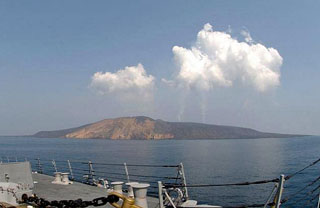Report on Jebel at Tair (Yemen) — 26 September-2 October 2007
Smithsonian Institution / US Geological Survey
Weekly Volcanic Activity Report, 26 September-2 October 2007
Managing Editor: Sally Sennert.
Please cite this report as:
Global Volcanism Program, 2007. Report on Jebel at Tair (Yemen) (Sennert, S, ed.). Weekly Volcanic Activity Report, 26 September-2 October 2007. Smithsonian Institution and US Geological Survey.
Jebel at Tair
Yemen
15.55°N, 41.83°E; summit elev. 244 m
All times are local (unless otherwise noted)
According to news reports, an eruption from the Jebel at Tair volcano was observed from several passing NATO ships on the evening of 30 September. Witnesses described a fissure eruption that produced lava fountains approximately 100 m high and ash plumes to a height of 300 m (1,000 ft) a.s.l. Multiple 1-km-long lava flows descended to the sea and a large landslide occurred on the W part of the island. Activity continued for at least two days.
The eruption prompted Yemeni authorities to evacuate about 50 soldiers from a military base on the island. A news article on 2 October reported that the Yemeni authorities lowered the death toll to three.
Two weeks prior to the eruption seismicity reportedly increased with earthquakes of M 2-3.6 recorded through 30 September.
Geological Summary. The basaltic Jebel at Tair volcano rises from 1,200 m depth in the south-central Red Sea, forming an oval-shaped island about 3 km long. It is the northernmost known Holocene volcano in the Red Sea and lies SW of the Farisan Islands. Youthful basaltic pahoehoe lava flows from the steep-sided central vent, Jebel Duchan, cover most of the island, draping a circular cliff cut by wave erosion of an older edifice and extending beyond it to form a flat coastal plain. Pyroclastic cones are located along the NW and S coasts, and fumarolic activity occurs from two uneroded scoria cones at the summit. Radial fissures extend from the summit, some of which were the sources of lava flows. Explosive eruptions were reported in the 18th and 19th centuries, prior to an eruption in 2007-2008.
Sources: IRIN News, Associated Press, Agence France-Presse (AFP), Agence France-Presse (AFP)

